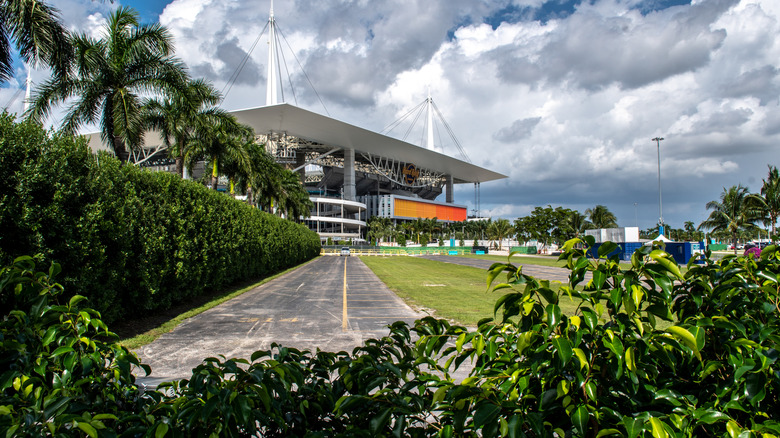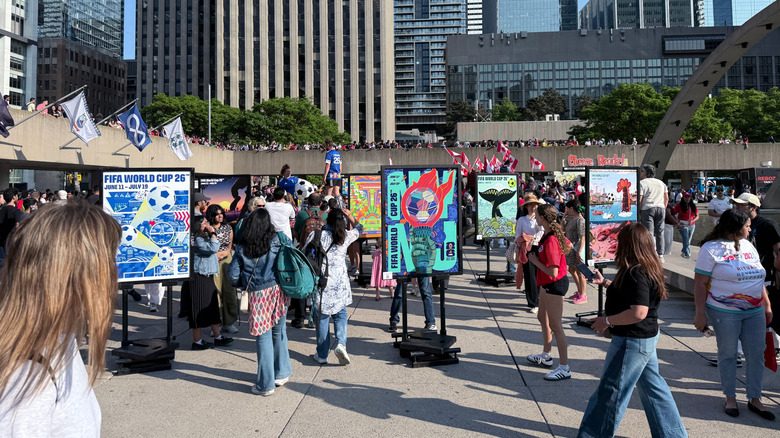What Tourists Need To Know About The 2026 FIFA World Cup Base Camps Before Planning A Trip
If you're already looking to secure tickets and plan ahead for the 2026 FIFA World Cup, you may want to consider visiting some of the lesser-known cities that have been chosen as base camps. These specially-chosen team "homes" are where the players will post up throughout the World Cup for practice, rest, and everything in between. While there are 16 cities hosting World Cup matches between Mexico, the U.S., and Canada, as of April 2025 there are 62 options (most of them in the U.S.) teams can choose from as their base camp, with more expected to be announced in the coming months. According to a FIFA fact sheet, "These options expand the possible geographic footprint of the tournament throughout North America." So, essentially, more cities beyond those already hosting get to join in on the fun.
That's great news for local fans who get bragging rights for welcoming a team into their town for the duration of their World Cup performance. It also gives superfans their own base to congregate and meet one another. However, we won't know which team is staying at which base camp until after the draw in December 2025. Once the teams know where their matches will be, they can then submit their picks for base camps — and they'll likely choose based on convenience and proximity.
So, if you're planning to get in on all the World Cup action, there could be a base camp option that gets you close to your favorite team away from the mania of the nearest host city. It's also a great excuse to explore areas you might not otherwise have visited on their own.
How are World Cup base camps chosen?
The potential base camps that have made the list so far had to meet a number of FIFA requirements to be considered. For one, the city needs to have a professional training facility, with approved pitch and player amenities, that's close to a hotel handpicked to cater to the team. The city also needs to check boxes for reliable transportation, medical and emergency services, support for international players, and secure environments that offer the team privacy.
Many of the cities that made it have top-notch university athletic fields, which makes sense considering FIFA's requirements. Some examples include the University of North Texas (Dallas-Denton), Penn State University (State College, Pennsylvania), Coastal Carolina University (Myrtle Beach), University of Kansas (Lawrence), and Kennesaw State University (Atlanta). Others offer equally suitable sports facilities, like the Atlanta United Training Centre (Atlanta), the U.S. Air Force Academy (Colorado Springs), the Great Park Sports Complex (Irvine, California), and Kino Sports Complex (Tucson).
Each base camp is attached to a pre-determined hotel, but don't think you're going to run into your favorite player at the vending machine. Base camp hotels are likely going to be reserved exclusively for the team, coaches, staff, family, etc., and any additional rooms probably won't be easy to come by. Plus, as the sports tourism trend is on the rise, most nearby hotels will book out faster than a Taylor Swift concert. Okay, maybe that's a slight exaggeration, but it's safe to say you won't be hanging out with the players in your pj's.
What every curious fan should know before booking their trip
Only 48 teams will make it to the World Cup stage in 2026, so which of these 62 cities will be picked by which team is still up in the air. That puts advance planners and budget travelers in a pickle, as planning ahead is the name of the game when it comes to World Cup tourism. Still, base camps are less likely to book out as quickly as host cities, and they offer fans a great opportunity to run into hordes of other superfans at local sports bars.
Alas, the days of going to the local college field to watch your favorite team practice are pretty much over. According to the FIFA requirements for base camps (via The Athletic), a secure perimeter must be established around the fields and facilities, with the view obstructed up to over 8 feet high. That said, if you plan it right, you may be able to find a nearby accommodation (hello, Airbnb!) with a view over the field. However, given the long list of requirements for these base camps, it's possible some effort was made to prevent lookie-loos from getting free game previews.
Regardless, if AmeriStarRail comes through on its goal of connecting major cities via a transcontinental train route from New York to Los Angeles by 2026, there may be even more convenient side quests travelers can check out between host cities and base camps across the U.S. So before you lose hope after balking at the hotel prices in a host city, remember there are plenty of places still up for grabs in convenient proximity to the best of the World Cup action. And who knows — you might even bump into your favorite keeper in town.


